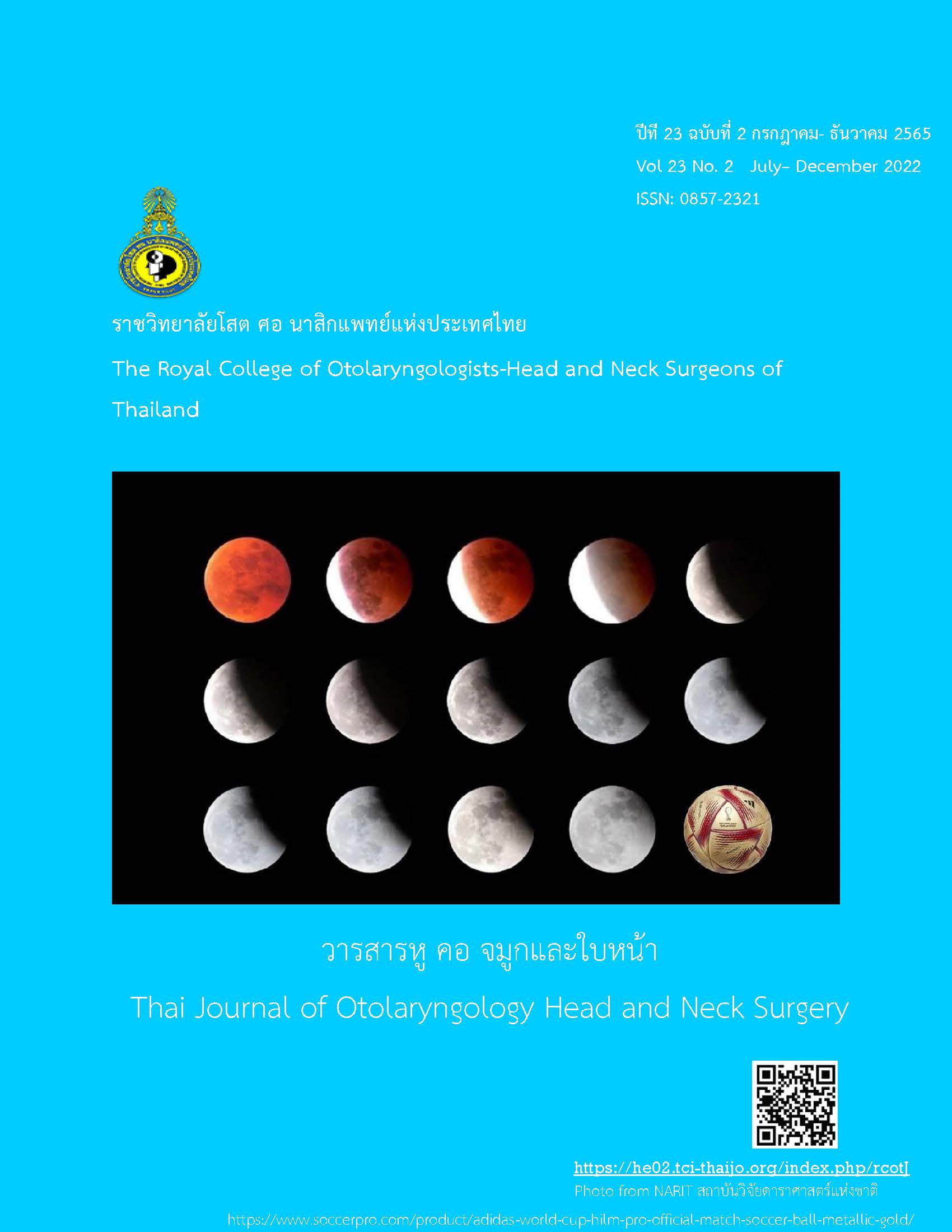A Comparative Study on the Suture Method after Total Laryngectomy that Provide no Leakage under Highest Tension in Swine Small Intestine Suture Method after Laryngectomy that Provide no Leakage
Main Article Content
Abstract
ABSTRACT
Background: Pharyngocutaneous fistula is one of the most catastrophic complications after surgical treatment for neoplasm of larynx or lower pharynx. It may result in poor wound healing, prolonged
hospitalization, and delayed radiotherapy/chemotherapy, or eventually death. Suture technique in constructing a neopharynx is a main controllable factor in decreasing the incidence of pharyngocutaneous fistula.
Objectives: To compare four commonly used suture techniques after total laryngectomy (Connell, interrupted Lembert, continuous Lembert, and simple interrupted) that provides highest burst pressure.
Methodology: This is an experimental study. Cadaveric swine intestines were recruited (30 per group). Each suture technique was performed in each group. The time spent for sutures were recorded. The burst pressure was measured using air leak test. All data were presented as mean and standard deviation (SD) and analysed using One-way analysis (ANOVA), Multiple comparison test, and Fisher’s exact test. The P-value
Results: The statistically significantly (P < 0.05) highest burst pressure was achieved using the Connell technique (155.87 ± 44.45 mmHg) compared tointerrupted Lembert (122.90 ± 42.57 mmHg), and simple interrupted (79.97 ± 39.28 mmHg) In addition, the mean time spent for completing the sutures were also significantly shortest (P < 0.05) for the Connell technique (287.77 s)
Conclusion: The Connell technique provided the highest leak pressure and lowest time spent for constructing the neopharynx. However, our study did not study the effects of each suture technique on luminal stenosis, tensile strength and blood supply. Further study should be conducted in vivo.
Keywords: pharyngocutaneous fistula, burst pressure, suture technique, laryngectomy
Article Details

This work is licensed under a Creative Commons Attribution-NonCommercial-NoDerivatives 4.0 International License.
ต้นฉบับที่ส่งมาพิจารณายังวารสารหู คอ จมูก และใบหน้า จะต้องไม่อยู่ในการพิจารณาของวารสารอื่น ในขณะเดียวกันต้นฉบับที่จะส่งมาจะผ่านการอ่านโดยผู้ทรงคุณวุฒิ หากมีการวิจารณ์หรือแก้ไขจะส่งกลับไปให้ผู้เขียนตรวจสอบแก้ไขอีกครั้ง ต้นฉบับที่ผ่านการพิจารณาให้ลงตีพิมพ์ถือเป็นสมบัติของวารสารหู คอ จมูกและใบหน้า ไม่อาจนำไปลงตีพิมพ์ที่อื่นโดยไม่ได้รับอนุญาต
ตารางแผนภูมิ รูปภาพ หรือข้อความเกิน 100 คำที่คัดลอกมาจากบทความของผู้อื่น จะต้องมีใบยินยอมจากผู้เขียนหรือผู้ทรงลิขสิทธิ์นั้นๆ และใหร้ะบุกำกับไว้ในเนื้อเรื่องด้วย
References
REFERENCES
The Global Cancer Observatory WHO.
Cancer Incidence and Mortality Worldwide and by Region. 2020.
Statistics report of tobacco consumption in Thailand 2018 [Internet]. 2019 [cited December 12,
.Available From: https://www.trc.or.th/th/ media/attachments/2562/01/29/2561.pdf
Incidence, Mortality and Prevalence by cancer site in Thailand [Internet]. 2020. Available
from:https://gco.iarc.fr/today/data/ factsheets/populations/764-thailand-fact- sheets.pdf
NCCN Clinical Practice Guidelines in Oncology, Head and Neck Cancer [Internet]. 2021 [cited July
, 2021]. Available from: https://www.nccn.org/professionals/physicia n_gls/pdf/head-and-neck.pdf
Mattioli F, Bettini M, Molteni G, et al. Analysis of risk factors for pharyngocutaneous fistula
after total laryngectomy with particular
focus on nutritional status. Acta Otorhinolaryngol Ital. 2015;35(4):243-248.
Dedivitis RA, Ribeiro KCB, Castro MAF, et al. Pharyngocutaneous fistula following total
laryngectomy. Acta Otorhinolaryngol Ital. 2007;27(1):2-5.
Bearelly S, Wang SJ. Predictors of Salivary
Fistulas in Patients Undergoing Salvage Total Laryngectomy. Int Sch Res Notices. 2014:373825.
Qureshi SS, Chaturvedi P, Pai PS, et al. A prospective study of pharyngocutaneous fistulas
following total laryngectomy. J Cancer Res Ther. 2005;1(1):51-6.
Auletta L, Lamagna F, Uccello V, et al. In vitro comparison of three suture techniques for
anastomosis of the equine small intestine. Equine Vet J Suppl. 2011(40):46-50.
Govindasamy G, Shanmugam S, Murugan
A. A review of pharyngeal mucosal closure technique in total laryngectomy. International Journal of
Otorhinolaryngology and Head and Neck Surgery. 2019;5(1):145-8.
Sajid MS, Siddiqui MR, Baig MK. Single layer versus double layer suture anastomosis of the
gastrointestinal tract. Cochrane Database Syst Rev. 2012;1:CD005477.
Dungthakol N, Art-smart T, Ratanaanekchai T, Vatanasapt P. Pharyngocutaneous Fistula Following
Total Laryngectomy Comparing between the Early and Delayed Oral Feeding. Srinagarind Medical
Journal. 2016;31(2) (March-April).
Deniz M, Ciftci Z, Gultekin E . Pharyngoesophageal Suturing Technique May
Decrease the Incidence of Pharyngocutaneous Fistula following Total Laryngectomy. Surg Res Pract. 2015:363640.
Myers EN. The management of pharyngocutaneous fistula. Arch Otolaryngol. 1972;95(1):10-7.
Mullen KM, Regier PJ, Waln M, et al. Ex vivo comparison of leak testing of canine jejunal
enterotomies: Saline infusion versus air insufflation. Vet Surg. 2021;50(6):1257-66.
Cohen J. Statistical power analysis for the behavioral sciences. 2, editor. New York 1977 1977.
Eickhoff R, Eickhoff SB, Katurman S, et al. Influence of suture technique on anastomotic
leakage rate-a retrospective analyses comparing interrupted-versus continuous-sutures. Int J
Colorectal Dis. 2019;34(1):55-61.
Kim J-S, Jeong S-W, Kim J-Y,et al. A comparison of three suture techniques on adhesion in end-
to-end intestinal anastomosis of dogs. Journal of Veterinary Clinics. 2003;20(1):12-21.
Farman RH. Laparoscopic colotomy suture using clips and Connell techniques in goats: A
comparative study. Al-Qadisiyah Journal of Veterinary Medicine Sciences 2015;14(1).
Kieves NR, Krebs AI, Zellner EM. A Comparison of Ex Vivo Leak Pressures for Four Enterotomy
Closures in a Canine Model. J Am Anim Hosp Assoc. 2018;54(2):71-6.
Weisman DL, Smeak DD, Birchard SJ, et al.
Comparison of a continuous suture pattern with a simple interrupted pattern for enteric closure in
dogs and cats: 83 cases (1991-1997). J Am Vet Med Assoc. 1999;214(10):1507-10.
Phillips B. Reducing gastrointestinal anastomotic leak rates: Review of challenges and
solutions. Journal of Open Access Surgery. 2016;(9):5-14.
Guyton KL, Hyman NH, Alverdy JC. Prevention of Perioperative Anastomotic Healing Complications:
Anastomotic Stricture and Anastomotic Leak. Adv Surg. 2016;50(1):129-41.
Shureih SF, Wilson TH Jr, Howard WH. Modified Gambee stitch. Safe, easy and fast modification.
Am J Surg.1981;141(2):304. doi:10.1016/0002-9610(81)90182-3.
Hui Y, Wei WI, Yuen PW, et al. Primary closure of pharyngeal remnant after total laryngectomy
and partial pharyngectomy: how much residual mucosa is sufficient? Laryngoscope. 1996;106(4):490-4.
Chotipanich A. Total Laryngectomy: A Review of Surgical Techniques. Cureus. 2021;13(9):e18181.
Kanters AE, Shubeck SP, Sandhu G, et al. Justifying our decisions about surgical technique:
Evidence from coaching conversations. Surgery. 2018;164(3):561-5.
White HN, Golden B, Sweeny L, et al. Assessment and incidence of salivary leak following laryngectomy. Laryngoscope. 2012;122(8):1796-9.
Genden EM, Rinaldo A, Shaha AR, et al. Pharyngocutaneous fistula following laryngectomy. Acta
Otolaryngol. 2004;124(2): 117-2
Aminpour S, Leonard R, Fuller SC, et al. Pharyngeal wall differences between normal younger and older adults. Ear Nose Throat J. 2011 Apr;90(4):E1.doi: 10.1177/014556131109000412. PMID: 21500153.
Jonsson K, Jiborn H, Zederfeldt B. Breaking strength of small intestinal anastomoses. Am J
Surg. 1983;145(6):800-3.


